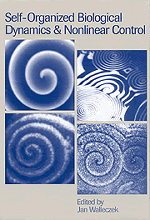 Self-Organized Biological Dynamics and Nonlinear Control
Self-Organized Biological Dynamics and Nonlinear Control Book contents
- Frontmatter
- Contents
- List of contributors
- Preface
- The frontiers and challenges of biodynamics research
- Part I Nonlinear dynamics in biology and response to stimuli
- Part II Nonlinear sensitivity of biological systems to electromagnetic stimuli
- 6 Electrical signal detection and noise in systems with long-range coherence
- 7 Oscillatory signals in migrating neutrophils: effects of time-varying chemical and electric fields
- 8 Enzyme kinetics and nonlinear biochemical amplification in response to static and oscillating magnetic fields
- 9 Magnetic field sensitivity in the hippocampus
- Part III Stochastic noise-induced dynamics and transport in biological systems
- Part IV Nonlinear control of biological and other excitable systems
- Index
6 - Electrical signal detection and noise in systems with long-range coherence
Published online by Cambridge University Press: 14 August 2009
- Frontmatter
- Contents
- List of contributors
- Preface
- The frontiers and challenges of biodynamics research
- Part I Nonlinear dynamics in biology and response to stimuli
- Part II Nonlinear sensitivity of biological systems to electromagnetic stimuli
- 6 Electrical signal detection and noise in systems with long-range coherence
- 7 Oscillatory signals in migrating neutrophils: effects of time-varying chemical and electric fields
- 8 Enzyme kinetics and nonlinear biochemical amplification in response to static and oscillating magnetic fields
- 9 Magnetic field sensitivity in the hippocampus
- Part III Stochastic noise-induced dynamics and transport in biological systems
- Part IV Nonlinear control of biological and other excitable systems
- Index
Summary
Introduction
The long-running controversy over the possibility of health effects from weak, environmental electric and magnetic fields (e.g., 60-Hz power line fields) has both advanced and obscured the study of field interactions with biological systems. While a substantial number of publications focus on theoretical limits of field detection, the efforts by some to disprove the possibility of health effects has drawn attention away from the broad and fascinating range of well-established field interaction phenomena. In this chapter, I review some of the fundamentals of electric field interactions with biological systems, extend these concepts to systems with long-range coherence, and discuss implications for research and therapy. Those readers interested in the detailed mathematical analysis of these processes are directed to appropriate treatments in the literature.
It should come as no surprise that applied electric fields can affect biological systems. Organisms at all levels of complexity both generate and use electric fields in development and function. Early work by L. Jaffe showed that a number of organisms generate electric fields during development (Jaffe and Nuccitelli, 1977). More recent work by Shi and Borgens (1995), Hotary and Robinson (1994) and others revealed that such fields are ubiquitous and may play a key role in tissue organization. Electric fields produced by embryos appear to direct the placement and differentiation of certain cells into structural and functional components of the developing organism. As investigators attempt to tease apart this intricate, self-directing symphony, we can gain insights by looking at a more comprehensible and immediately relevant process — wound healing.
- Type
- Chapter
- Information
- Self-Organized Biological Dynamics and Nonlinear ControlToward Understanding Complexity, Chaos and Emergent Function in Living Systems, pp. 147 - 172Publisher: Cambridge University PressPrint publication year: 2000
- 1
- Cited by


